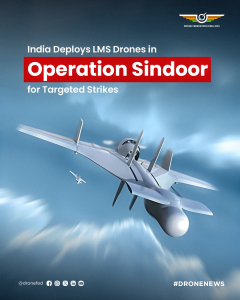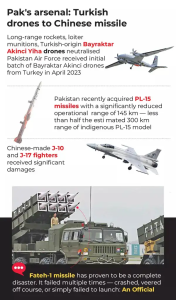Font size:
Print
Operation SINDOOR: A Powerful Leap Toward Aatmanirbhar Bharat in Defence Strategy
Operation SINDOOR: Driving India’s Inspiring March to Aatmanirbhar Bharat in Defence

Context: Operation SINDOOR, launched in May 2025, marked a turning point in India’s military strategy and symbolises a shift in Modern Warfare. It was a calibrated, non-escalatory response to the April 22 Pahalgam terror attack. Focused on the use of autonomous warfare, precision strikes, and indigenous technologies. Represented India’s transition from conventional response to technology-driven, strategic retaliation.
Technological Backbone of the Operation
- Unmanned Aerial Systems (UAS) and Loitering Munitions
-
-
- SkyStriker Drones: Jointly developed with Israel, manufactured in India.
- Nagastra-1: Indigenous GPS-guided loitering munition with high precision.
- Harop Drones: Israeli-origin, used to destroy radar and air defence systems.
-
- Integrated Air Defence Systems
-
- Akash Missile System: Indigenous, mobile, multi-target SAM with ECCM capabilities.
- Akashteer System: Enabled real-time coordination and 100% interception success.
- IACCS (Integrated Air Command and Control System): Backbone of net-centric operations, linking radars, airbases, and weapon platforms.

- Electronic Warfare and Satellite Surveillance
-
- DRDO EW Systems: Jammed enemy radars and missile guidance systems.
- ISRO Satellite Assets: Enabled real-time situational awareness and surveillance across 7,000 km coastline and northern borders.
- Fusion of space-based sensors and tactical decision-making enhanced operational accuracy.
Pakistan’s Response and Indian Defensive Success
- Pakistan’s Drone and Missile Offensive
-
-
- Attempted strikes using Shahpar-II, Bayraktar TB2, and Wing Loong II drones.
- Coordinated attacks on Srinagar, Jammu, Pathankot, Amritsar, Bhuj on 7–8 May.
-
- India’s Multi-Layered Defence Grid
-
- Legacy systems: Pechora, OSA-AK, LLAD guns.
- Modern systems: Akash-NG, S-400 Sudarshan Chakra.
- Integrated Counter-UAS Grid neutralised all threats; zero damage to Indian assets.
- Joint Force Coordination: Indian Army and Air Force coordinated to protect civilian and military infrastructure during May 9–10 retaliation attempts.
Indigenous Capability and Strategic Autonomy
- Post-2014 Reforms for Self-Reliance
-
-
- Focus on co-development, co-production, and IDDM (Indigenously Designed, Developed and Manufactured) technologies.
- Major reforms:
-
- Corporatisation of Ordnance Factory Board (OFB)
-
-
- Defence Industrial Corridors in Tamil Nadu and Uttar Pradesh
- iDEX (Innovations for Defence Excellence) initiative
-
- Key Indigenous Achievements and reasons
-
- LCA Tejas, Agni-V ICBM, ASAT missile
- Home-grown UAVs, loitering munitions, EW systems, missiles, and radars
- Rise of the Indian Drone Ecosystem
- Private Sector Participation
-
-
- Drone Federation of India (DFI): Represents over 550 companies and 5,500+ certified pilots.
- Vision: India as global drone hub by 2030.
-

- Enablers: Ease of Doing Business, Bharat Drone Mahotsav, PLI Schemes.
- Major Contributors
-
-
- Alpha Design Technologies: Partners with Israel for SkyStriker drones.
- Tata Advanced Systems, Paras Defence & Space Technologies, IG Drones: Key players in defence drone production.
-
- Market Growth
-
-
- India’s drone market is projected at $11 billion by 2030.
- Will constitute 12.2% of the global drone market.
-
- Policy and Export Boost for Defence Production
- Production Linked Incentive (PLI) Scheme for Drones (2021)
- Incentive of ₹120 crore over three years.
- Encouraged AI-powered drones, autonomous navigation, and local manufacturing.
- Record Domestic Production and Exports
- FY 2023–24: Indigenous defence production reached ₹1.27 lakh crore.
- FY 2024–25: Defence exports hit ₹23,622 crore, a 34x increase since 2013–14.
- Target by 2029: ₹3 lakh crore in production and ₹50,000 crore in exports.
Conclusion: Strategic Autonomy through Technological Superiority
- Operation SINDOOR was not just a military response, but a demonstration of strategic autonomy.
- Highlighted:
- Technological preparedness and precision warfare
- Indigenous capabilities across land, air, sea, space, and cyber domains
- Seamless civil-military-private sector integration
- Marks a paradigm shift towards a self-reliant India prepared for future conflicts shaped by autonomous, electronic, and digital warfare.
Embodies the spirit of Aatmanirbhar Bharat in national security.

